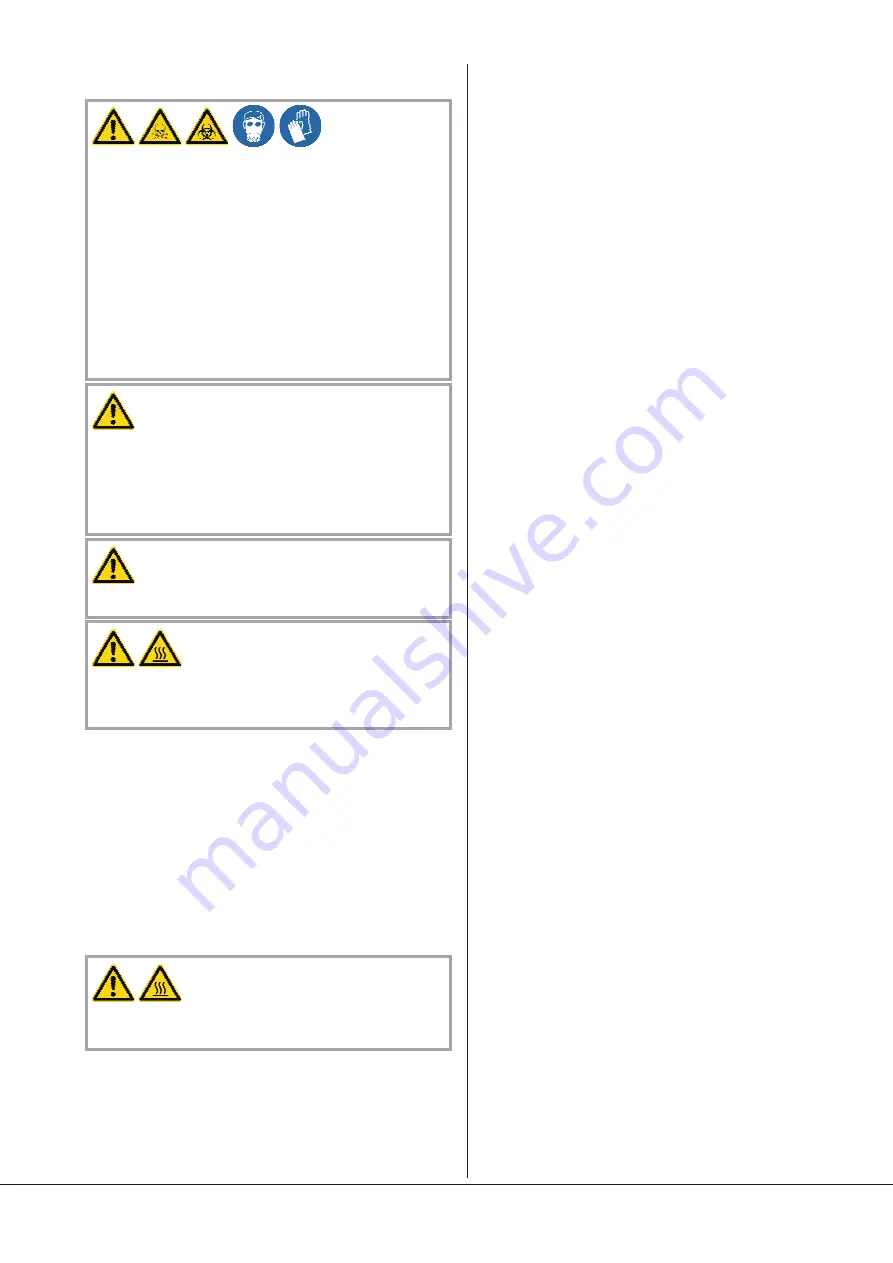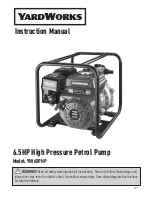
Maintenance
DANGER
In case the vacuum pump has conveyed gases that have been
contaminated with foreign materials that are dangerous to health,
the oil and condensates will also be contaminated.
These foreign materials can infiltrate the pores, recesses and other
internal spaces of the vacuum pump.
Danger to health when the vacuum pump is dismantled.
Danger to the environment.
Always wear protective clothing when carrying out maintenance
work.
Before any maintenance work, the inlet and outlet piping as well as
the vacuum pump itself must be flushed with nitrogen.
CAUTION
Only authorised personnel may carry out dismantling work on the
vacuum pump. Before work begins, the operator of the vacuum
pump must fill in a form or a “Declaration Regarding Contamination
of Equipment and Components” that provides information on
possible dangers and appropriate measures.
If this form has not been filled in completely and signed, the
vacuum pump may not be dismantled.
CAUTION
Before maintenance work is started, a safety area of at least 610
[mm] around the machine must be set up.
CAUTION
The surface temperature of the vacuum pump can exceed 50°C
when the vacuum pump is in operation.
Danger of burns!
Before starting maintenance work, make sure that the vacuum pump
has been switched off and that it cannot be switched on again acciden-
tally. Follow the shutdown procedure in the section “Lock Out/ Tag
Out procedure”:
–
stop the pump with the remote control (press on STOP button
during 10s)
–
press on emergency stop button
–
switch off the main disconnect switch
–
switch off the customer’s power supply
–
switch off the water (inlet first, then outlet) and nitrogen quick
connections
–
put the label or warning board “Maintenance processing” on or
next to the pump
CAUTION
The oil temperature can reach a value of 90°C!
Danger of burns!
l
Make sure that the oil circuit and the coolant circuit have been
emptied before moving the vacuum pump
l
Make sure that there are no cleaning tools in the pump anymore
according to local and national regulations
Before pulling off the different connections, make sure that the intake
and exhaust lines of the vacuum pump correspond to atmospheric
pressure
When the maintenance work has been finished, follow the procedure
“Safety Lockout procedure”:
–
take off the label or warning board “Maintenance processing”
–
check the cooling liquid and oil levels according to the chapters
“Checking the oil level” and “Checking the cooling liquid level”
–
open the power box cover and check that the FDP1 thermal relay
is on manual reset position
–
close the cover
–
switch on the main disconnect switch
–
release the emergency stop button
–
switch on the water (outlet first, then inlet) and nitrogen quick
connections
–
make sure that the “Necessary installation instructions” are
followed
–
start the pump with the remote control (press on START button)
Maintenance program
NOTE
: The maintenance intervals depend on the operating conditions.
The following intervals are basic values, which can be shortened or
lengthened depending on operating conditions. In especially difficult
operating conditions such as, for example, a very dusty environment
the maintenance intervals must be shortened considerably.
Weekly:
l
Check the oil level and the colour of the oil (see “Checking the
oil”)
l
Check the level of the cooling liquid (see “Checking the cooling
liquid”)
l
Check the cooling water flow (see “Checking the cooling water”)
l
Check the nitrogen flow (see “Checking the nitrogen”)
l
Inspect the vacuum pump for oil leaks - if there are leaks, repair
the vacuum pump (Busch)
l
Inspect the vacuum pump for leaks of cooling liquid - if there are
leaks, repair the vacuum pump (Busch)
l
Inspect the vacuum pump for leaks of cooling water - if there are
leaks, repair the vacuum pump (Busch)
Monthly:
In the case of operation in a dusty environment:
u
Make sure that the operating room is clean and free of dust;
clean if necessary
l
Make sure that the vacuum pump has been switched off and that
it cannot be switched on again accidentally
l
Check the electrical connections
l
Carry out a visual inspection of the vacuum pump
Yearly:
l
Make sure that the vacuum pump has been switched off and that
it cannot be switched on again accidentally
If the intake is equipped with a sieve:
u
Check the sieve at the intake and clean if necessary
l
Check the measuring and safety equipment for working order
If the discharge is equipped with a sound absorber:
u
Clean the sound absorber
If the discharge is equipped with a leak-protection non-return valve:
u
Clean the leak-protection non-return valve
l
Drain the cooling liquid (see “Draining the cooling liquid”)
If the cooling water line is equipped with a filter:
u
Check the filter and clean or replace if necessary
l
Check the seals and replace if necessary
l
Check the intake and discharge lines and clean or replace if
necessary
DS 3010 E
Maintenance
0870771509 (En)
Page 19














































